Machine learning and manufactured intellect (AI) are two appearing fields that are being put on almost all regions of science. Because of recent advancements in materials sciences, the forensic field is currently also benefitting from manufactured intelligence.
How is Schindlers Forensics AI assisting forensic science?
Data analysis
Digital forensics can be an future field that is on top of computation and requires research of large and sophisticated data units. Here, AI offers a good tool to take care of and deal with these large data units.
For instance, AI may be used to execute a meta-analysis of the meta-data produced from various resources, and pool those to simplify complicated data. This may decrease the data of the form into a simplified and understandable format in a comparatively short time of time.
Pattern recognition
Figuring out specific types of habits in large data is one of the key components of forensic science. This might involve image routine recognition where in fact the software tries to recognize various areas of a graphic or a person. In the same way, there could be other varieties of pattern popularity, such as discovering habits in a text message like electronic mails, or habits in a audio file.
Pattern recognition is dependant on heavy reports and probabilistic reasoning. AI will come to identify such habits in sophisticated data in a far more accurate manner. A number of the features may entail finding certain types of pictures or predicated on a knowledge of how humans understand information.
Providing legal solutions
Forensic reports provides scientific solutions to treat information for the legal system. With an increase of complex and comprehensive information directories, AI provides fast answers to the legal community when required.
Enhancing communication between all customers of the forensic team
Forensic inspection requires communication between forensic statisticians, solicitors, criminal investigators, and more. Mis-communication between these get-togethers can result in incorrect decisions or misinterpretation of data resulting in delayed or incorrect justice. AI really helps to bridge this communication distance between different lovers in this field.
Building statistical evidence
Forensic science entails aiding the narrative and quarrels with strong statistical research. AI can build visual set ups that can support building situations and case reviews. Additionally, it may help build visual model situations you can use to show or disprove quarrels, helping regulations to make smarter judgments.
AI provides numerical and computational tools that will help to develop statistically relevant and significant information. All this will certainly reduce the problems and increase the knowledge of the information behind a report.
Creating repositories
AI can also help build a web repository that can store all the digital forensic investigations, data, properties, and results. Together with the exponential rate of development of storage area capacity, such as USB, hard disks, optical media, adobe flash drives that can store large levels of information, it is now harder for forensic knowledge researchers to store and evaluate all of this data. AI can be considered a good tool to store, review and utilize this data for legal purposes.
Knowledge discovery
Data mining and knowledge finding are other domains that require the utilization of AI. Datamining is a combo of AI, statistical examination, and probabilistic methods that are used mutually to acquire and review large examples of data. Because of the extensive size of data, normal computational methods might not exactly prove useful.
During data mining, an individual may require certain data files to be highlighted which contain specific information and regards to the user. This may aid in the procedure of pattern identification. AI can also help avoid evident patterns and give attention to habits of relevance.
